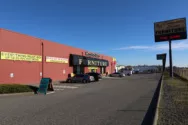
Home » Ag industry tries to find footing in changing world
State of agriculture
Ag industry tries to find footing in changing world

Derek Sandison, director of the Washington State Department of Agriculture, right, presents a Washington state gift to Philippine Secretary of Agriculture Francisco Tiu Laurel Jr.
Courtesy Washington State Department of AgricultureJune 12, 2025

Derek Sandison, Washington State Department of Agriculture
Washington’s agriculture remains one of the most diverse and productive sectors in the nation – anchoring our economy, sustaining rural livelihoods and supplying food to communities, both locally and globally. From tree fruit and specialty crops to dairies and shellfish, farming is not just a business here – it’s part of who we are. Yet as we move through 2025, the industry is navigating a rapidly evolving landscape shaped by market volatility, extreme weather disruptions, labor shortages and global economic uncertainty.
These headwinds are challenging, but not unfamiliar. Time and again, Washington’s producers have met adversity with grit, creativity and a strong sense of purpose. Their continued commitment to innovation and sustainability is what drives the industry forward.
Industry at a glance
This past year has highlighted a pivotal transition across Washington’s ag sector, with shifting consumer demands, supply imbalances and environmental stressors influencing nearly every corner of the industry.
Key trends include:
- Crop surpluses strain markets: Overproduction of apples, wine grapes and hops has saturated markets, driving prices down and increasing financial strain for growers.
- Labor remains a top concern: Persistent workforce shortages have made it difficult for many farms to maintain full operations, increasing costs and complicating harvest planning.
- Weather extremes hit yields: A severe cold snap in early 2024 devastated pear crops, leading to the smallest harvest in 40 years and highlighting the sector’s vulnerability to climate extremes.
- Tech adoption accelerates: More producers are investing in precision agriculture tools – from drone mapping to automated irrigation – to boost efficiency and reduce inputs.
- Tastes evolve, markets shift: Demand is trending toward premium and aromatic wine varieties like sauvignon blanc and pinot gris, pointing to new market opportunities for growers willing to adapt.
As the industry finds its footing in a changing world, there is real potential for growth through innovation, smarter resource management and responsiveness to consumer trends.
Cost pressures mount
Input costs remain a critical concern. Rising expenses for fuel, fertilizer, machinery and labor are cutting into already narrow margins. According to recent analyses from the U.S. Department of Agriculture’s Economic Research Services, farm operating costs in Washington have increased by over 20% in just the past year while the inflation-adjusted net farm income has decreased by 43%.
Smaller and mid-sized operations are especially vulnerable. The effects are compounded by stagnant commodity prices and limited flexibility in passing on costs through the supply chain.
Producers are adapting wherever possible, but long-term viability requires both innovation and supportive policy.
Labor challenges
Farm labor continues to be a significant cost driver for many agricultural operations, especially those reliant on seasonal labor for harvesting crops like apples, cherries and asparagus. Recent overtime wage requirements for agricultural labor have further increased operating costs.
For employers utilizing the federal H-2A program to address labor shortages, the Adverse Effect Wage Rate is nearly $20 per hour – before accounting for the additional costs of housing, transportation and other requirements tied to bringing workers into the state. These rising expenses continue to place financial pressure on Washington growers as they work to meet labor demands and keep their operations economically viable.
Climate stress, water scarcity
Like last year, we have seen major impacts from climate volatility leading the state Department of Ecology to issue a drought declaration for the third year in a row. This is a clear indicator of water stress, particularly in the Yakima Valley and other irrigated regions.
Water availability and management are now central to agricultural planning. Investing in infrastructure and flexibility – alongside conservation and resilience strategies – must remain a priority at both the state and federal level.
The Washington State Department of Agriculture (WSDA) has introduced initiatives such as the Washington State Soil Health Initiative and Saving Tomorrow’s Agricultural Resources to promote sustainable farming through improved soil health.
These programs aim to ensure that today’s agricultural productivity can be maintained – or even enhanced – over the next 50 years by managing natural resources responsibly.
Shifting federal landscape
Federal policies on trade, labor, conservation and energy continue to shape Washington agriculture. While we recognize the importance of national decision-making, it's also clear that changes in federal priorities – whether budget adjustments, trade policy shifts or regulatory changes – can have ripple effects across our farm economy.
This year, we’re closely monitoring evolving dynamics in trade relationships, particularly with China and other key export markets. We also recognize the uncertainty surrounding tariffs and retaliatory tariffs, which can create instability for producers and exporters alike. While the full impact of trade policy shifts can take time to unfold, it’s an area we’re watching closely and staying engaged on through state and federal channels.
In addition, we’re keeping a close eye on federal discussions around agricultural spending, research funding, and infrastructure investment. Regardless of political changes, our focus remains steady: advocating for Washington agriculture, building strong relationships with trade partners and ensuring the consumer has access to safe, high-quality products.
Investing in our future
One of the most important steps we’ve taken in the past year is deepening our understanding of long-term viability. In May 2024, WSDA and Washington State University co-hosted the Agricultural Viability Conference in Kennewick. This event brought together stakeholders across the industry – growers, food processors, agricultural business owners, researchers, policymakers and community leaders – to discuss the critical factors influencing competitiveness.
That input, along with new data collected by WSU’s IMPACT Center, will inform the Washington State Agricultural Viability Study, an initiative funded by the state Legislature to provide actionable recommendations for the future of farming in our state.
We’re grateful to everyone who participated in the study’s surveys and conversations. Your insights are instrumental in shaping the next steps. Study results will be available in summer 2025.
Facing the future
As we move further into 2025, one thing is clear: Agriculture in Washington is at a pivotal juncture. The pressures facing our producers are complex, but so are the strengths and innovations that define this industry. Washington farmers and ranchers have repeatedly shown their ability to adapt, lead and thrive – even in the face of uncertainty.
It’s in this spirit of resilience that I look ahead with both humility and determination. I’m honored to have been reappointed by Gov. Bob Ferguson to continue serving as director of the WSDA. At a time when the challenges are significant – but so are the opportunities – I remain committed to working alongside our agricultural community to ensure a strong, viable future for the industry that supports us all.
Derek Sandison is the director of the Washington State Department of Agriculture.
Agriculture + Viticulture
KEYWORDS June 2025
Related Articles
Related Products





